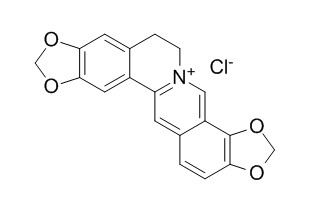Coptisine chloride
Coptisine is an isoquinoline alkaloid isolated from Coptidis Rhizoma with anti-diabetic, antimicrobial, antiviral, anti-hepatoma, and anti-leukemia effects. Coptisine protects rat heart against myocardial ischemia/reperfusion injury by suppressing myocardial apoptosis and inflammation. Coptisine chloride can be absorbed across intestinal epithelial cells, and completely absorbed compounds.
Inquire / Order:
manager@chemfaces.com
Technical Inquiries:
service@chemfaces.com
Tel:
+86-27-84237783
Fax:
+86-27-84254680
Address:
1 Building, No. 83, CheCheng Rd., Wuhan Economic and Technological Development Zone, Wuhan, Hubei 430056, PRC
Providing storage is as stated on the product vial and the vial is kept tightly sealed, the product can be stored for up to
24 months(2-8C).
Wherever possible, you should prepare and use solutions on the same day. However, if you need to make up stock solutions in advance, we recommend that you store the solution as aliquots in tightly sealed vials at -20C. Generally, these will be useable for up to two weeks. Before use, and prior to opening the vial we recommend that you allow your product to equilibrate to room temperature for at least 1 hour.
Need more advice on solubility, usage and handling? Please email to: service@chemfaces.com
The packaging of the product may have turned upside down during transportation, resulting in the natural compounds adhering to the neck or cap of the vial. take the vial out of its packaging and gently shake to let the compounds fall to the bottom of the vial. for liquid products, centrifuge at 200-500 RPM to gather the liquid at the bottom of the vial. try to avoid loss or contamination during handling.
NanoBioScience2024, v13:3:115.
J Control Release.2021, 336:159-168.
University of Limpopo2016, 1777
Life Sci.2023, 317:121458.
Microb Pathog.2019, 131:128-134
Food Chem.2023, 424:136383.
Molecules.2020, 25(21):5087.
Daru.2022, 30(2):273-288.
Sci Rep.2025, 15(1):29590.
Fitoterapia.2022, 105141.
Related and Featured Products
Zhongguo Zhong Yao Za Zhi. 2007 Dec;32(23):2523-7.
[Absorption of coptisine chloride and berberrubine across human intestinal epithelial by using human Caco-2 cell monolayers].[Pubmed:
18330249 ]
To study the absorption of Coptisine chloride (COP) and berberrubine (BRB) as chemical constituents of some traditional Chinese medicines in human intestinal epithelial.
METHODS AND RESULTS:
By using Caco-2 (the human colonic adenocarcinoma cell lines) cell monolayers as an intestinal epithelial cell model, the permeability of Coptisine chloride and BRB were studied from apical side (AP side) to basolateral side (BL side) or from BL side to AP side. The two alkaloids were measured by reversed-phase high performance liquid chromatography (HPLC) coupled with UV detector. Transport parameters and apparent permeability coefficients (P(app)) were then calculated and compared with those of propranolol and atenolol. P(app) values were also compared with the reported values for model compounds (propranolol and atenolol). The P(app) values of Coptisine chloride, BRB were (1.103 +/- 0.162) x 10(-5), (1.309 +/- 0.102) x 10(-5) cm x s(-1 from AP side to BL side, and (0.300 +/- 0.041) x 10(-5) and (1.955 +/- 0.055) x 10(-5) cm x s(-1) from BL side to AP side, respectively. Their P(app) values were identical with those of propranolol [(2.23 +/- 0.10) x 10(-5 cm x s(-1)], which is a transcellular transport marker and as a control substance for high permeability. On the other hand, the efflux transport of BRB was higher 1.49 times more than its influx transport with 0.67 rate of P(app A-->B)/P(app B-->A). But P(app A-->B)/P(app B-->A value of Coptisine chloride was 3.67, which suggested that the efflux transport have not been involved in its absorbed mechanism in Caco-2 cells monolayers.
CONCLUSIONS:
Coptisine chloride and BRB can be absorbed across intestinal epithelial cells, and they are completely absorbed compounds. BRB may have been involved in efflux mechanism in Caco-2 cells monolayers model from the basolateral-to-apical direction.
Tumour Biol . 2017 Mar;39(3):1010428317694565.
Coptisine-induced cell cycle arrest at G2/M phase and reactive oxygen species-dependent mitochondria-mediated apoptosis in non-small-cell lung cancer A549 cells[Pubmed:
28351307]
Abstract
This study aimed to explore the effect of coptisine on non-small-cell lung cancer and its mechanism through various in vitro cellular models (A549). Results claimed significant inhibition of proliferation by coptisine against A549, H460, and H2170 cells with IC50 values of 18.09, 29.50, and 21.60 μM, respectively. Also, coptisine exhibited upregulation of pH2AX, cell cycle arrest at G2/M phase, and downregulation of the expression of cyclin B1, cdc2, and cdc25C and upregulation of p21 dose dependently. Furthermore, induction of apoptosis in A549 cells by coptisine was characterized by the activation of caspase 9, caspase 8, and caspase 3, and cleavage of poly adenosine diphosphate ribose polymerase. In addition, coptisine was found to increase reactive oxygen species generation, upregulate Bax/Bcl-2 ratio, disrupt mitochondrial membrane potential, and cause cytochrome c release into the cytosol. Besides, treatment with a reactive oxygen species inhibitor (N-acetyl cysteine) abrogated coptisine-induced growth inhibition, apoptosis, reactive oxygen species generation, and mitochondrial dysfunction. Thus, the mediation of reactive oxygen species in the apoptosis-induced effect of coptisine in A549 cells was corroborated. These findings have offered new insights into the effect and mechanisms of action of coptisine against non-small-cell lung cancer.
Keywords: A549 cells; Coptisine; apoptosis; cell cycle arrest; cytotoxicity; reactive oxygen species.



